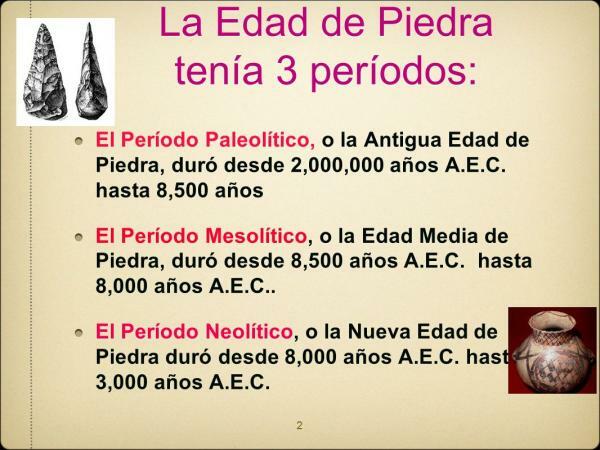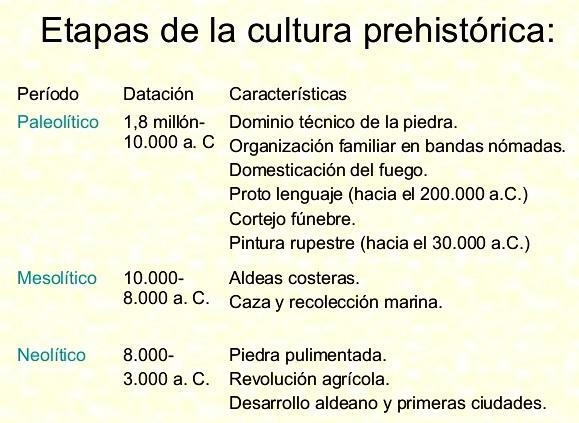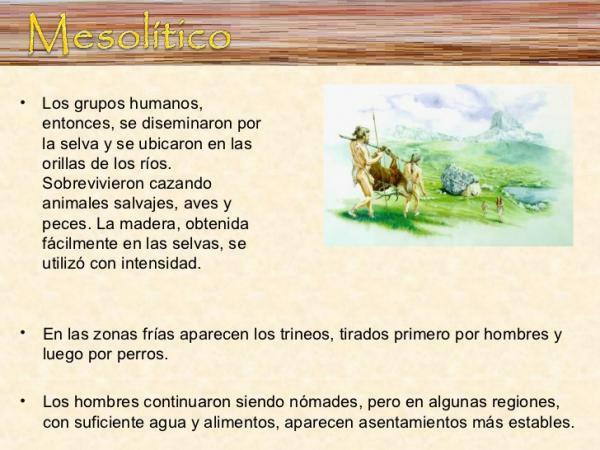Stone Age periods

Image: SlidePlayer
The history of mankind is divided into numerous periods, some more relevant than others, but all of them important. A part of history is Prehistory, this being the name of the entire part prior to the creation of writing by human beings. One of the most relevant stages of Prehistory is the Stone Age, and that is why in this lesson from a PROFESSOR we are going to talk about the stone age periods.
Index
- What is the Stone Age?
- Paleolithic, one of the stages of the Stone Age
- Mesolithic: main characteristics
- Neolithic, the last period of the Stone Age
What is the Stone Age?
The Stone Age is that part of the Prehistory which begins with the manufacture of first stone utensils and that ends with the arrival of metal tools. So we could place this period between 2.5 million years ago, and around year 3000 a. C, thus being one of the longest stages in the history of mankind.
Stone Age periods and characteristics
The Stone Age can be divided into three periods, these being the
Paleolithic, the Mesolithic and the Neolithic. Each of these stages has a series of differential characteristics, but the three also have common ones, these being the main characteristics of the Stone Age. These characteristics are as follows:- Starts on sedentary lifestyle of human beings, putting aside their nomadic nature.
- The main material was the stone, but tools were also created with wood and bone.
- Their transition to sedentary beings causes humans to discover the farming.
- Domestication of the first animals.
- First examples of Commerce between different human groups.
- Total mastery of the fire.

Image: Prehistory
Paleolithic, one of the stages of the Stone Age.
The Paleolithic is the first of the periods into which the Stone Age is divided, beginning 2.5 billion years ago, and ending around 12,000 years ago. It is considered as the longest stage of the entire history of humanity, covering in proportion more than 90% of our history.
The Paleolithic also has an internal division by epochs, dividing into Lower, Middle and Upper Palaeolithic. Being such a great difference of years, there are great differences between the three periods, an example being the discovery of fire in the lower one.
Paleolithic characteristics
To understand the differences between the Paleolithic and the rest of the stages of the Stone Age, we must talk about its main characteristics. The most common characteristics of the Paleolithic are the following:
- It was a time marked by glaciations, turning human beings into nomads, who were looking for the area with the best climate.
- First creations of tools using stone, although they were very primitive.
- First artistic representations in the caves, what we currently call cave paintings.
- They were gatherers and hunters, although they only hunted small prey, feeding only on the carrion of large animals.
- The weapons used for hunting were made by sharp stones, such as the tips of spears and arrows.
- The first Familiar groups They were formed at this stage, dividing depending on the function they performed.
- They must have had some kind of concept of religion, since they performed certain rites such as the burial of the deceased.
- One of the most representative elements of this stage is the VenusFigures that are believed to have been made to receive divine aid in hunting.
- The elaboration of the stone tools went through 4 phases throughout the period, each phase being much more advanced than the previous one.

Image: IHMC Public Cmaps
Mesolithic: main characteristics.
To continue with this lesson on the Stone Age periods, we must talk about the Mesolithic, being the intermediate stage between the Paleolithic and the Neolithic. It is thought to begin around 10,000 BC. C and ends around 6,000 BC. C., divided into two stages called Epipaleolithic and Protoneolithic.
It is considered the last stage of the tribes based on hunting and gathering, but this is not the only important characteristic of this period. Some of the main characteristics of the Mesolithic are the following:
- They were generally nomadic, but in some situations and in certain areas sedentary people could be observed.
- A more temperate climate, which clearly helps communities need less shelter.
- Vegetation increased in much of the world, numerous new foods are emerging for humans.
- The production of the fishing increased, creating new methods to improve this system.
- Rock art was changed to a much more abstract one.
- The first producers in front of the hunter-gatherers, assuming the rupture that gave way to the Neolithic.

Image: Slideshare
Neolithic, the last period of the Stone Age.
The Neolithic is the last of the three periods into which the Stone Age is divided, being a stage of great evolution of humanity, achieving great achievements such as the appearance of livestock or the development of rougher tools. The period can be between the 6,000 a. C and 3,000 a. C., date that gives begins to the denominated Age of Bronze.
Like the two aforementioned stages, the Neolithic is also divided, its divisions being the initial, middle and final Neolithic. Each of these stages has its own characteristics, being the environment in which the aljafería took more importance, but all of them have a series of similarities, which are the main characteristics of the Neolithic.
Main characteristics of the Neolithic
Some of these characteristics are the following:
- Happens again a climate change, making the climate much more temperate, changing the customs of human beings.
- The agriculture and livestock appear, putting the gatherers in the background. Thanks to this, human beings did not have to change their location, and could stay in a single place.
- The entire population becomes sedentary, thanks in part to the climate and the emergence of agriculture.
- Appearance of the aljafería, with which it was able to create new utensils that greatly facilitated people's lives.
- Start to use the polished stone to create tools, instead of carved stone.
- The loom to create clothing that protects from the cold.

Image: Borja Gimeno - WordPress.com
If you want to read more articles similar to Stone Age periods, we recommend that you enter our category of Story.



